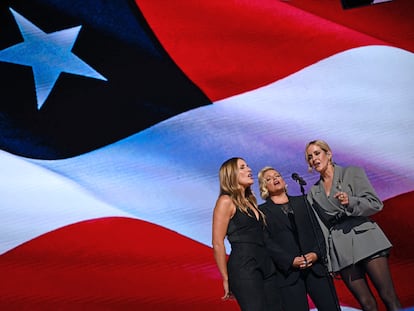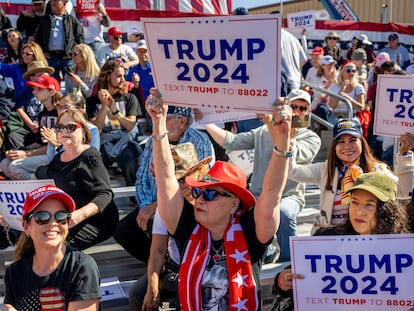The fight for Wisconsin: The eternal swing state, seen from the street that divides the two Americas
The rural-urban divide and ideological entrenchment have marked the campaign in a place that, in the last four elections, voted for the candidate who ended up winning the White House
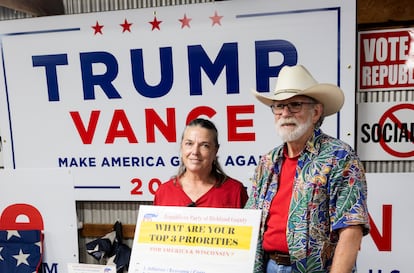

Rarely do the two Americas come into such close contact as on the main street of Richland Center, a town in the middle of Wisconsin. It’s where the iconic architect Frank Lloyd Wright was born.
On one side of the street is the county office of the Democratic Party, an old gas station freshly painted blue-and-white, with signs asking passersby to “vote” and “think about the future.” And, just across the street, a house — with a huge black pickup truck parked out front — displays an XL banner that shouts “Trump-Vance” and “Make America Great Again.” There are also smaller lawn signs that only have the name of the former president, along with Republican candidates lower down the ballot who are running in the November elections. fgsgsd
Mary Collins — chairwoman of the county Democrats — tells EL PAÍS that she doesn’t know the Trumpist neighbor personally, nor does she even know his name. However, on a couple of occasions, he has “yelled at her from the other end of the street” while she was on the phone. Dennis Fry — treasurer for the county Democrats — confirms that, “just like everywhere else,” politics has complicated coexistence in recent years in this rural community. “Lifelong friends are lost, there are people who don’t spend money at businesses whose owners think differently from them,” he sighs.
In that, Richland Center is a mirror of America. This town of about 5,000 inhabitants is located in the agricultural county of the same name. So far, this century, the county has voted for the candidate who ended up winning the White House. That is, except in 2020, when Donald Trump (54.1%) defeated Joe Biden (44.4%) in Richland Center, although Biden ultimately won Wisconsin by a handful of votes and seven-tenths of a percentage point.
Such a narrow margin isn’t a rarity in Wisconsin: in four of the last six presidential elections, the winner was determined in the state by a difference of less than 1%. The exception four years ago in Richland County confirms another rule: the power that Trump has in the rural electorate hasn’t stopped growing in this corner of America.
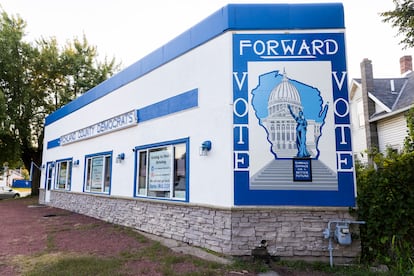
Richland is one of those places where nothing ever happens, except when it’s campaign season and it becomes a swing county in one of the seven swing states. Wisconsin — in addition to its milk production, its custom of frying cheese curds and its beer culture, all inherited from heavy German immigration — is also famous for its longevity in the league of these decisive territories. The club of purple states rarely admits new members.
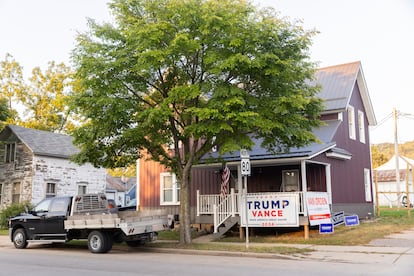
Florida, Missouri and Ohio used to be three major swing states, although they’re now solidly Republican. “Over the past 40 years — even 20 — the number of purple states has shrunk as a result of political polarization and partisan loyalty,” writes David Schulz — editor of the valuable book Presidential Swing States (2018)— in an email. “Democrats vote overwhelmingly Democratic and Republicans vote decidedly Republican, reducing the number of undecided voters.” This means that, in a country of 330 million people, “between 150,000 and 200,000 of those undecided voters — from a few key counties, in a handful of swing states — will be the ones to decide the next president,” according to Schulz’s calculations.
These states — Wisconsin included — survive campaign after campaign as members of that exclusive club. They receive an unusual amount of attention every four years. The two major political parties flood them with campaign ads, while presidential candidates visit them again and again, ignoring the rest of the vast territory. In one of her brilliant imitations of Democratic candidate Kamala Harris on Saturday Night Live, comedian Maya Rudolph invented the definitive name for the imaginary place where the future of the United States will be decided: “Wisconsi-Pensyl-Va-Georgia.”
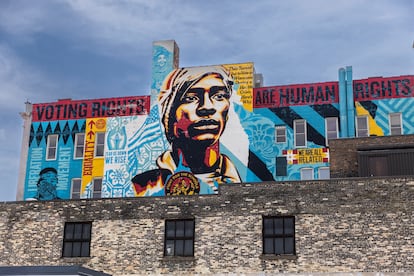
Influential political journalist Craig Gilbert has covered every campaign in the Midwest since 1988 for the Milwaukee Journal Sentinel. Now retired from journalism, he works as a researcher at Marquette University in Milwaukee. He recalls that “during Clinton’s time [1993-2001] there were as many as 20 swing states.” If some with similar characteristics ended up definitively painted Democratic blue (like neighboring Minnesota) or Republican red (like Iowa, in the southwest), it’s because, Smith explains, “one of the trends that have cancelled each other out” prevailed. “Rural areas have become more Republican in the last 20 years, while the suburbs have become more Democratic. What has happened here is that these changes have occurred in similar proportions and have ended up resulting in a zero-sum phenomenon. That’s the key to Wisconsin: the balance between rural, suburban and urban voters,” he believes.
Democrats’ hopes are pinned on places such as Dane County, Madison and its large suburb, which have the fastest-growing population in the state. Students and professionals are drawn to the University of Wisconsin and the burgeoning health and technology industries. But Gilbert advises that the Democratic Party shouldn’t take its eyes off the western part of the state, a region where one in six voters lives, which includes Richland County. It’s an area that’s in the crosshairs of both campaigns much more than its small population would suggest: one day last August, Harris and J. D. Vance coincided at rallies in Eau Claire, the largest city in western Wisconsin. It’s also a piece of land attached to Minnesota: separated by the Mississippi River, but united by the fact that its inhabitants receive the television signal (with its load of Democratic ads) from the neighboring state.
That makes the area an excellent place to gauge how Harris’s vice presidential nominee — Minnesota Governor Tim Walz, a small-town boy — will impact voters in Middle America.
“[Richland County] has seen some of the biggest shifts in the country toward the GOP in the Trump era,” Gilbert wrote in a recent analysis. “[But] even amid those changes, it remains more competitive than its demographic makeup — overwhelmingly white, mostly rural and working-class — would suggest. Democrats have lost ground there. But there still aren’t many places in the middle of the country where they do better with rural white voters.”
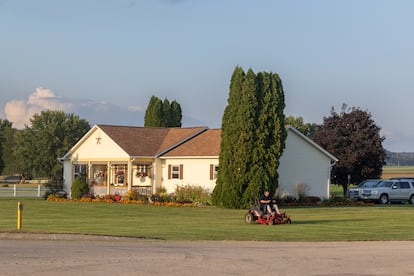
Demographics are one reason why the 120 miles or so separating Richland Center from Milwaukee — the state’s largest city — seems like a distance of light years. With its public safety problems, its fireworks museum, its Black mayor (the first in the city’s history) and its hipster neighborhoods, Milwaukee is also the only city in Wisconsin — a state with almost six million inhabitants, 85% of whom are white — where the majority is an ethnic minority: African Americans, descendants of those who escaped from the South during the 20th century as part of the Great Migration.
In July, the Republican Party put the overwhelmingly Democratic city to the test by hosting its convention there. In another demonstration of the importance of conquering that space, Harris and Walz took a break from their Convention’s celebrations in Chicago a month later to hold a massive rally in the same stadium where Trump had been cheered by his supporters just a few days after surviving an assassination attempt.
In early September, in a taco shop in Milwaukee, Michael Mirer — who will be volunteering again in these elections — argues that this rural-urban divide is actually due to the spirit that governs each party: “The Republican individualist fantasy fits better with rural life, while the Democratic spirit of integration and cosmopolitanism is more compatible with the urban experience.”
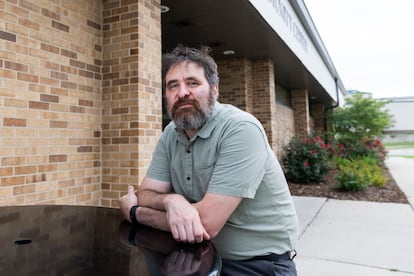
Mirer also ventured that this year’s elections might serve to consolidate the trend of 2020, when Biden won. The current composition of the Wisconsin Supreme Court — which has had a progressive majority since last year — could contribute to this. Among its most famous rulings are a decision that facilitates voting by mail (in 2020, Wisconsin was one of the states where Trump, alleging fraud, unsuccessfully tried to challenge the results without access) and a ruling that overturned the electoral maps drawn up by the Republicans in the Wisconsin State Legislature. The previous ones greatly favored them, by virtue of the perfectly legal — yet undemocratic — technique of gerrymandering.
On October 2— just over a month before Americans go to the polls — the Marquette Law School Poll was published. According to the website FiveThirtyEight, this is the third-most reliable survey in the country. The poll gives Harris a four-point lead over Trump, practically the same as at the beginning of September. All the analyses agree that the most direct path to victory for the Democrats is to win here, as well as in Pennsylvania and Michigan. Together, these three swing states form what is known as the Blue Wall.
Harris has the advantage
During a telephone interview with EL PAÍS, Charles Franklin — director of the Marquette Law School Poll — explained that they’ve conducted a couple of polls that track independents shifting towards the vice president, who could become the first woman in history to occupy the Oval Office. He also notes that the current stagnation in the numbers — amidst a campaign that has been filled with unforeseen events — is due to “a term that political scientists coined — ‘calcification’ — to define the idea that the electorate is increasingly rigid in its opinions and enjoys its entrenchment.”
“The supporters of each party,” Franklin adds, “see the issues very differently. They don’t react the same to the news and they value the personality of the candidates in a radically different way.”

Richland Center is an excellent setting for this. On the day of our visit, the quiet life of the town — which, in addition to a warehouse (an early work by Lloyd Wright), has a hotel called the White House — was taking place at the county fair, with cotton candy, a Ferris wheel and cow beauty pageants. There, both parties set up shop — separated by a partition — in a barn.
The president of the county Republicans — 77-year-old Bruce Taylor — was born and raised in the area. He recently returned to buy his grandfather’s farm and retire in Richland Center. Taylor was asking visitors about the issues that most concern them on the way to the polls. Immigration and the border were two of the most frequently mentioned, despite the fact that the white population in the county is 96%.
It seems that Trump’s xenophobic message has penetrated even the states furthest from the border with Mexico. In places such as Eau Claire, refugee-accommodation plans — which are necessary to sustain the local economy — have been met with fierce opposition, as the Republican candidate knowingly spreads lies about Haitians eating pets in an Ohio town.
For Taylor, “these are issues that have to do with ideology, with the heart.” Still, he clarifies that “they’re not as important to people here as the economy; people vote with their pocketbooks and farmers are having a hard time paying the bills.” This — coupled with an aging, retiring population — is contributing to the disappearance of family farms in Wisconsin: their number fell by 7.5% last year, a drop similar to that of previous years. Taylor blames these ills on Democratic Senator Tammy Baldwin, who represents the state on Capitol Hill. His goal, he affirms, is to “throw her out in November.”
“She’s been in Washington for 25 years,” he laments. “She became an insider a long time ago — she no longer represents our interests.”
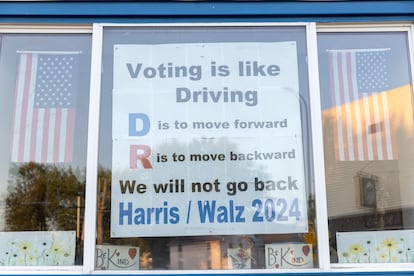
Baldwin’s race is one of the crucial battles for control of the Senate — something essential for the next president to be able to push through their agenda. According to the Marquette poll, Baldwin is seven points ahead of her rival, finance executive Eric Hovde. The senator recently visited Richland Center and held a rally outside the Democratic Party’s county office, on the corner where the two Americas face each other. The event was interrupted on several occasions by men shouting pro-Trump slogans from their cars.
It’s easy to imagine that the spectacle must not have pleased the neighbor with the black pickup truck and the Republican signs, although it wasn’t possible to ask him. This newspaper’s attempts to contact the gentleman through the telephone directory were unsuccessful. “It surely didn’t make him very happy, but I can’t know for sure,” says Dennis Fry, the treasurer for the county’s Democratic Party. Apparently, the pro-Trump neighbor didn’t step out of his house that day.
Sign up for our weekly newsletter to get more English-language news coverage from EL PAÍS USA Edition
Tu suscripción se está usando en otro dispositivo
¿Quieres añadir otro usuario a tu suscripción?
Si continúas leyendo en este dispositivo, no se podrá leer en el otro.
FlechaTu suscripción se está usando en otro dispositivo y solo puedes acceder a EL PAÍS desde un dispositivo a la vez.
Si quieres compartir tu cuenta, cambia tu suscripción a la modalidad Premium, así podrás añadir otro usuario. Cada uno accederá con su propia cuenta de email, lo que os permitirá personalizar vuestra experiencia en EL PAÍS.
¿Tienes una suscripción de empresa? Accede aquí para contratar más cuentas.
En el caso de no saber quién está usando tu cuenta, te recomendamos cambiar tu contraseña aquí.
Si decides continuar compartiendo tu cuenta, este mensaje se mostrará en tu dispositivo y en el de la otra persona que está usando tu cuenta de forma indefinida, afectando a tu experiencia de lectura. Puedes consultar aquí los términos y condiciones de la suscripción digital.
More information
Archived In
Últimas noticias
Most viewed
- Sinaloa Cartel war is taking its toll on Los Chapitos
- Oona Chaplin: ‘I told James Cameron that I was living in a treehouse and starting a permaculture project with a friend’
- Reinhard Genzel, Nobel laureate in physics: ‘One-minute videos will never give you the truth’
- Why the price of coffee has skyrocketed: from Brazilian plantations to specialty coffee houses
- Silver prices are going crazy: This is what’s fueling the rally
